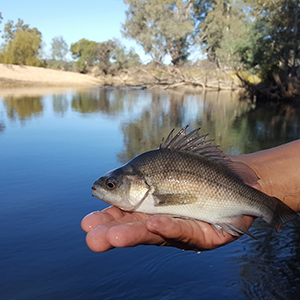Larval fish sensitivity to a simulated cold-water pulse varies between species and age

Accepted: 27 June 2022
Supplementary: 167
HTML: 135
All claims expressed in this article are solely those of the authors and do not necessarily represent those of their affiliated organizations, or those of the publisher, the editors and the reviewers. Any product that may be evaluated in this article or claim that may be made by its manufacturer is not guaranteed or endorsed by the publisher.
Authors
The release of cold-water from hypolimnetic zones of impoundments sharply reduces downstream riverine water temperature. This cold-water pollution (CWP) can extend for hundreds of kilometres, severely challenging the physiological ability of aquatic fauna, particularly ectotherms such as fish, to maintain essential processes such as metabolism, development and growth and survival. The impact of CWP on native fish, especially early life stages, is poorly known. We investigated the effect of a 24-hour exposure to a range of environmentally-related water temperatures (8, 10, 12, 14, 16, 18 and 20°C) on three age-classes (<24-hour-old, 7-day and 14-day-old larvae) of two Australian native fish species: Murray cod (Maccullochella peelii) and Macquarie perch (Macquaria australasica). Overall, larvae of M. peelii were more sensitive to lower water temperatures and hence CWP than M. australasica, indicated by higher rates of equilibrium loss. Larvae of M. peelii were most sensitive to exposure at seven days old whereas M. australasica larvae were most sensitive at <24-h-old. Using our results, we modelled pre- and post-impoundment temperature scenarios and estimated the downstream CWP footprint for both species in an Australian river reach. Larvae of M. peelii were predicted to be absent from the first 26 km of river downstream of the impoundment compared with no impact on the distribution of M. australasica. Managing riverine water temperature below impoundments is fundamental to promoting positive outcomes for endemic fish on not only a local, but global basis. This study emphasises the differential impact of CWP among the critical early life stages and fish species and highlights the urgent need to better manage hypolimnetic water releases to improve downstream river ecosystems.
Edited by
Pietro Volta, CNR-IRSA Verbania, ItalyHow to Cite

This work is licensed under a Creative Commons Attribution-NonCommercial 4.0 International License.
Similar Articles
- Cristina Pulido, Joan Lluís Riera, Enric Ballesteros, Eglantine Chappuis, Esperança Gacia, Predicting aquatic macrophyte occurrence in soft-water oligotrophic lakes (Pyrenees mountain range) , Journal of Limnology: Vol. 74 No. 1 (2015)
- Rui Ye, Kun Shan, Hailong Gao, Ruibin Zhang, Shuai Wang, Xin Qian, Long-term seasonal nutrient limiting patterns at Meiliang Bay in a large, shallow and subtropical Lake Taihu, China , Journal of Limnology: Vol. 74 No. 3 (2015)
- María I. Ríos-Pulgarín, Isabel C. Gil-Guarín, Mario Barletta, Néstor J. Mancera-Rodríguez, Effects of the hydrological cycle on the phycoperiphyton assemblage in an Andean foothill stream in Colombia , Journal of Limnology: Vol. 75 No. s1 (2016): Proceedings of the 6th National Congress of Limnology
- Dorota Górniak, Renata Tandyrak, Katarzyna Parszuto, Joanna Misiun, Relationships between physico-chemical and microbiological parameters in the monimolimnion of a forest meromictic lake , Journal of Limnology: Vol. 73 No. 3 (2014)
- Souhaib Hanfouri, Fayçal Ait Boumallassa, Mohamed Naimi, Mohamed Znari, Plasticity of life-history traits in the Draa barbel Luciobarbus lepineyi (Pellegrin, 1939) (Actinopterygii: Cyprinidae) in the sub-Saharan Draa basin, Morocco: effect of change in flow regime and salinity , Journal of Limnology: Vol. 83 (2024)
- Marta Marchegiano, Elsa Gliozzi, Simona Ceschin, Ilaria Mazzini, Thierry Adatte, Roberto Mazza, Daniel Ariztegui, Ecology and distribution of living ostracod assemblages in a shallow endorheic lake: The example of the Lake Trasimeno (Umbria, central Italy) , Journal of Limnology: Vol. 76 No. 3 (2017)
- Sylvia Bonilla, Mauricio González-Piana, Maria C.S. Soares, Vera L.M. Huszar, Vanessa Becker, Andrea Somma, Marcelo M. Marinho, Mikołaj Kokociński, Martin Dokulil, Dermot Antoniades, Luis Aubriot, The success of the cyanobacterium Cylindrospermopsis raciborskii in freshwaters is enhanced by the combined effects of light intensity and temperature , Journal of Limnology: Vol. 75 No. 3 (2016)
- Eliana A. Panarelli, Daryl L. Nielsen, Aleicia Holland, Cladocera resting egg banks in temporary and permanent wetlands , Journal of Limnology: Vol. 80 No. 1 (2021)
- Daniele Paganelli, Renato Sconfietti, Biodiversity loss in a small riverine wetland of the Ticino river (Lombardia, Northern Italy) , Journal of Limnology: Vol. 72 No. 3 (2013)
- Shuchun Yao, Bin Xue, Sediment records of the metal pollution at Chihu Lake near a copper mine at the middle Yangtze River in China , Journal of Limnology: Vol. 75 No. 1 (2016)
<< < 13 14 15 16 17 18 19 20 21 22 > >>
You may also start an advanced similarity search for this article.
-
John D. Koehn, Charles R. Todd, Henry Wootton, Michael JoyMarine and Freshwater Research : 2023

 https://doi.org/10.4081/jlimnol.2022.2056
https://doi.org/10.4081/jlimnol.2022.2056





